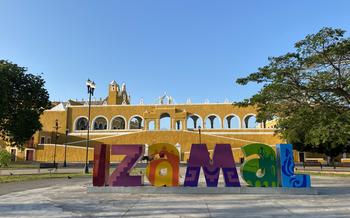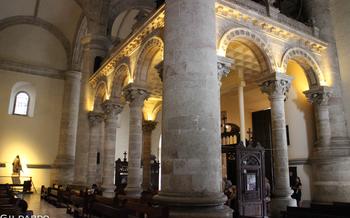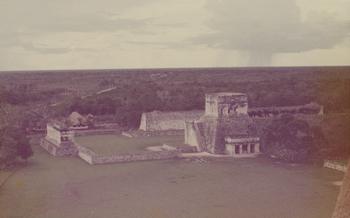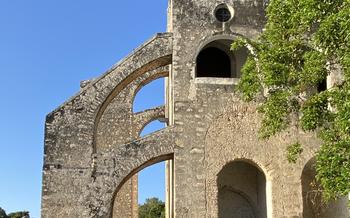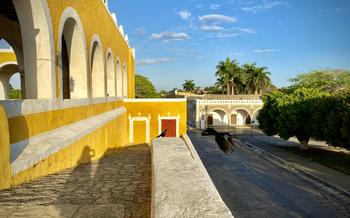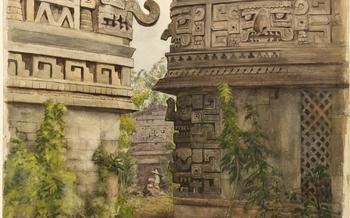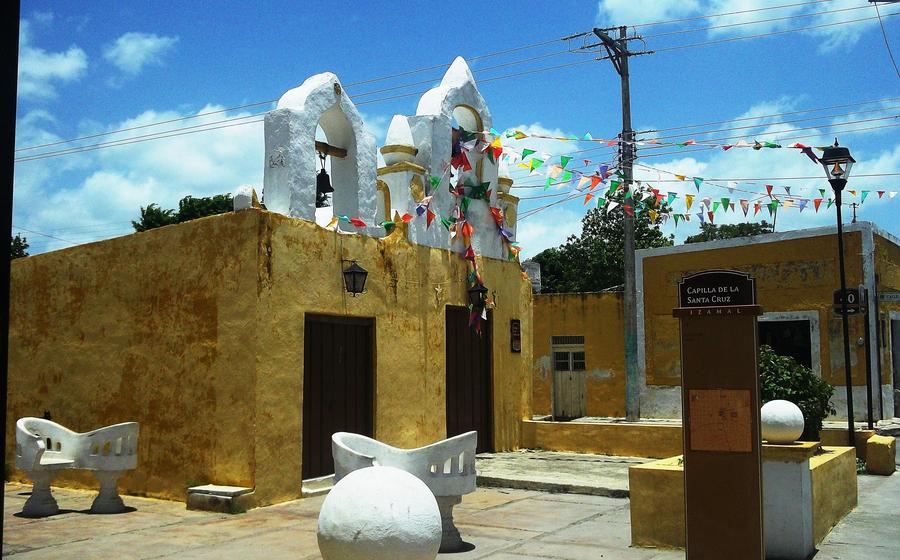
Capilla de Santa Cruz
- Location and Accessibility
- Architectural Beauty
- Religious Importance
- Intricate Murals and Frescoes
- Exploring the Neighborhood
- Guided Tours and Local Guides
- Photography and Respectful Behavior
- Visiting During Religious Events
- Local Handicrafts and Souvenirs
- Combining with Other Attractions
- Dress Code and Appropriate Attire
- Language Barriers and Communication
- Insider Tip: Hidden Gem
Location and Accessibility
The Capilla de Santa Cruz is conveniently situated in the heart of Izamal, a charming city in the Yucatán state of Mexico. It stands proudly on Calle 30, between Calle 29 and Calle 31, just a short walk from the city's main square, Plaza de la Constitución. Izamal is easily accessible by road, with well-maintained highways connecting it to major cities in the region, including Mérida, Valladolid, and Cancún.
To reach Izamal from Mérida, the capital of Yucatán, you can take a comfortable 45-minute bus ride. Buses depart regularly from Mérida's main bus terminal, and the journey offers a scenic glimpse into the lush Yucatán countryside. Alternatively, if you prefer a more personalized experience, you can rent a car and enjoy the flexibility of exploring the region at your own pace. The drive from Mérida to Izamal takes approximately 1 hour and 15 minutes.
Once in Izamal, the Capilla de Santa Cruz is within easy walking distance from most hotels and guesthouses. The city's compact size and well-marked streets make it a breeze to navigate on foot. However, if you prefer a more leisurely mode of transportation, you can rent a bicycle from one of the local shops and cycle your way through the charming streets of Izamal, taking in the sights and sounds of this vibrant city.
Architectural Beauty
The Capilla de Santa Cruz stands as a testament to the architectural prowess of the Spanish colonial era. Its exterior boasts a striking blend of Gothic and Renaissance styles, with intricate carvings adorning its facade. The entrance is flanked by two bell towers, each topped with a distinctive dome, creating a harmonious symmetry.
The interior of the chapel is equally captivating. The walls are adorned with vibrant murals depicting scenes from the Bible, creating a sense of awe and spirituality. The high vaulted ceilings, supported by graceful arches, add to the grandeur of the space. The main altar, intricately carved from wood and adorned with gold leaf, serves as a centerpiece, drawing the eye towards the sacred space.
The architectural style of the Capilla de Santa Cruz reflects the fusion of European and Mayan influences prevalent during the colonial period. Its design incorporates elements of both cultures, creating a unique and distinctive style that is emblematic of the rich history and cultural heritage of Mexico.
Religious Importance
The Capilla de Santa Cruz holds immense religious significance as a Catholic pilgrimage site, attracting devout worshippers and pilgrims from various parts of Mexico and beyond. It serves as a sacred destination for those seeking spiritual solace and connection with their faith. The chapel is dedicated to the Holy Cross, which is deeply revered in Catholic tradition. The patron saint of the chapel, Santa Cruz, is associated with divine protection, healing, and miracles. Numerous religious traditions and rituals are observed at the chapel, including special masses, processions, and prayer services. During these events, the chapel exudes an aura of devotion and spirituality, as pilgrims gather to pay homage to the Holy Cross and seek blessings. The chapel's religious importance is further enhanced by the presence of intricate murals depicting biblical scenes, which serve as a visual narrative of the Christian faith and contribute to the sacred ambiance of the space.
Intricate Murals and Frescoes
The Capilla de Santa Cruz is adorned with stunning murals and frescoes that depict biblical scenes and narratives. These artworks, created by talented Maya artisans under the guidance of Franciscan missionaries, are a testament to the fusion of indigenous and Catholic traditions. The murals showcase a unique blend of Maya iconography and European artistic techniques, creating a visually captivating display.
The vibrant colors, intricate details, and expressive figures bring the biblical stories to life, immersing visitors in the world of faith and devotion. The murals narrate tales of creation, redemption, and the life of Jesus Christ, offering a glimpse into the spiritual beliefs and values of the Maya people.
One of the most striking murals depicts the crucifixion of Jesus, surrounded by sorrowful figures representing the Virgin Mary, John the Evangelist, and other disciples. The emotional intensity and poignant expressions convey the depth of human suffering and the profound significance of the sacrifice.
Another notable mural portrays the Last Supper, capturing the moment of fellowship and intimacy between Jesus and his disciples. The table is laden with traditional Maya food, such as tortillas and tamales, reflecting the cultural assimilation and blending of traditions that took place during the evangelization process.
The frescoes and murals of the Capilla de Santa Cruz are not only artistic masterpieces but also valuable historical documents that provide insights into the cultural and religious exchange that shaped the identity of the Yucatan region.
Exploring the Neighborhood
Venturing beyond the walls of the Capilla de Santa Cruz, you'll find yourself immersed in the enchanting historic district of Izamal. This vibrant neighborhood is a testament to the city's rich heritage, boasting an array of landmarks and attractions that beckon exploration.
Stroll along the cobbled streets, lined with charming colonial buildings painted in vibrant hues of yellow, a distinctive feature that has earned Izamal the nickname, "Ciudad Amarilla" or "Yellow City." Admire the intricate facades adorned with intricate carvings and wrought-iron balconies, each a testament to the city's architectural prowess.
Among the notable landmarks in the vicinity is the Convento de San Antonio de Padua, a magnificent 16th-century monastery that stands as a symbol of the city's religious history. Explore its serene cloisters, marvel at the intricate murals that adorn its walls, and soak in the tranquil ambiance that permeates the air.
For a taste of local life, head to the bustling Mercado Municipal, a lively marketplace where vendors display an array of fresh produce, colorful handicrafts, and traditional Yucatecan delicacies. Engage with the friendly locals, sample exotic fruits, and savor the aromas of freshly prepared dishes that fill the air.
Indulge in the culinary delights of Izamal by trying the local specialties, such as cochinita pibil, a slow-roasted pork dish wrapped in banana leaves, or panuchos, thick tortillas topped with refried beans, shredded turkey, and a tangy tomato sauce.
To delve deeper into the city's history and culture, embark on a guided walking tour. Knowledgeable guides will lead you through the historic streets, sharing fascinating stories and anecdotes that bring Izamal's past to life.
As the sun begins to set, the city takes on a magical glow, its yellow buildings casting long shadows across the cobblestone streets. This is the perfect time to capture the essence of Izamal, as the day's hustle and bustle give way to a tranquil stillness.
Guided Tours and Local Guides
Guided tours in English and Spanish are available for visitors who want to delve deeper into the history and significance of the Capilla de Santa Cruz. These tours, often led by local experts or historians, provide insights into the chapel's architecture, religious importance, and cultural context.
Hiring a local guide is highly recommended for a more immersive and personalized experience. Guides can share stories and anecdotes that bring the chapel's history to life, helping visitors understand its role in the evangelization of the Maya people and its enduring legacy as a pilgrimage site.
Finding reputable tour operators is essential to ensure a quality experience. Look for companies that are licensed, have a good reputation, and offer tours that align with your interests and budget. Online reviews, recommendations from fellow travelers, and local tourist information centers can help you identify reliable tour operators.
Insider Tip: Consider booking a private tour for a more intimate and customized experience. This option allows you to set your own pace, ask specific questions, and tailor the tour to your interests.
Photography and Respectful Behavior
Etiquette and Respect Inside the Chapel
When visiting the Capilla de Santa Cruz, it's essential to be mindful of the sacred nature of the space and to exhibit respectful behavior towards both the locals and other pilgrims. Photography is permitted inside the chapel, but it's crucial to be discreet and avoid using flash, as it can be disruptive during religious services or prayers.
It's also important to be mindful of your surroundings and not block the passage of others or disturb those engaged in prayer. Refrain from talking loudly or engaging in conversations that may be distracting to others seeking tranquility and spiritual connection within the chapel.
Capturing the Essence of the Chapel
To capture the best shots of the chapel's intricate murals and architectural details, consider visiting during the early morning or late afternoon when the natural light is most favorable for photography. Using a tripod can help stabilize your camera and ensure crisp, sharp images.
Remember that the primary purpose of your visit should be to appreciate the spiritual significance of the chapel and to immerse yourself in its serene atmosphere. While taking photos is a wonderful way to document your experience, it should not detract from the sanctity of the space or the experiences of other visitors.
Visiting During Religious Events
Experience the Capilla de Santa Cruz during special events and festivals
Throughout the year, the Capilla de Santa Cruz plays host to a variety of religious events and festivals that draw pilgrims and visitors from near and far. These events offer a unique opportunity to witness the deep devotion and traditions of the local Catholic community.
One of the most significant events is the annual feast day of the chapel's patron saint, Santa Cruz, celebrated on May 3rd. During this festival, the chapel is adorned with colorful decorations, and a grand procession takes place through the streets of Izamal, accompanied by music, dancing, and prayers.
During Holy Week, the chapel becomes a focal point for solemn processions and reenactments of the Passion of Christ. Visitors can witness the moving reenactment of the Stations of the Cross, as well as the traditional "Burning of Judas" ceremony, where an effigy of Judas Iscariot is set ablaze to symbolize the triumph of good over evil.
For those seeking a truly immersive experience, attending one of these religious events at the Capilla de Santa Cruz is highly recommended. Remember to dress respectfully, maintain silence during ceremonies, and observe local customs to ensure a meaningful and respectful visit.
Local Handicrafts and Souvenirs
Strolling through the charming streets surrounding the Capilla de Santa Cruz, you'll encounter a vibrant array of artisanal markets and shops showcasing the exquisite handiworks of local artisans. These talented craftsmen pour their hearts and souls into creating unique pieces that reflect the rich cultural heritage of Izamal.
Among the must-have souvenirs to look out for are the intricately woven hammocks, a symbol of Yucatecan craftsmanship. These colorful creations, made from soft cotton or henequen fibers, are not only beautiful but also incredibly comfortable, inviting you to sink into relaxation and embrace the laid-back vibes of the region.
Hand-painted ceramics, adorned with vibrant motifs and intricate designs, are another popular choice. These decorative pieces, ranging from plates and bowls to vases and figurines, add a touch of Mexican flair to any home.
For those seeking a truly unique souvenir, the traditional Mayan huipiles, or blouses, are a must-see. Embroidered with vibrant colors and intricate patterns, these garments showcase the exceptional skills of local artisans and make for a stunning addition to any wardrobe.
By purchasing these handcrafted treasures, you not only take home a piece of Izamal's cultural heritage but also support the local community. Your purchases directly contribute to the livelihoods of these skilled artisans, ensuring that their traditions continue to thrive for generations to come.
Combining with Other Attractions
Izamal and the Yucatan Peninsula offer a wealth of attractions beyond the Capilla de Santa Cruz. A visit to the city can be easily combined with other nearby destinations to create a comprehensive itinerary. For a day trip, consider exploring the historic center of Izamal, visiting the Convento de San Antonio de Padua, and indulging in the local cuisine at one of the many traditional restaurants. If you have more time, venture further into the Yucatan Peninsula and discover ancient Maya ruins like Chichen Itza, Uxmal, and Tulum. These iconic sites offer a glimpse into the rich history and culture of the region.
To make the most of your time, consider the following itineraries:
- Day Trip: Start with a morning visit to the Capilla de Santa Cruz, followed by a walk through the historic center of Izamal. Visit the Convento de San Antonio de Padua and savor a delicious lunch at a local restaurant. In the afternoon, embark on a guided tour of the nearby ruins of Mayapán.
- Two-Day Itinerary: Dedicate the first day to exploring Izamal and its surroundings. On the second day, take a day trip to Chichen Itza, one of the New7Wonders of the World. Witness the impressive pyramid of El Castillo, explore the Great Ball Court, and learn about the ancient Maya civilization.
- Longer Stays: If you have more time, consider exploring other destinations in the Yucatan Peninsula, such as the colonial city of Valladolid, the vibrant port city of Progreso, or the stunning beaches of the Riviera Maya.
No matter your interests or time constraints, Izamal and the Yucatan Peninsula offer an array of attractions and experiences to suit every traveler.
Dress Code and Appropriate Attire
When visiting the Capilla de Santa Cruz, it is important to be mindful of the local customs and religious sensibilities. A respectful dress code is expected, which means avoiding revealing or overly casual clothing. Opt for modest attire that covers your shoulders and knees. While shorts and tank tops may be acceptable for exploring the town, they are not appropriate for entering the chapel.
When in doubt, it is always better to err on the side of caution and dress conservatively. This shows respect for the religious significance of the site and helps create a solemn and reverent atmosphere. By dressing appropriately, you can fully immerse yourself in the spiritual and cultural experience that the Capilla de Santa Cruz offers.
Language Barriers and Communication
In Izamal and the Yucatan region, Spanish is the primary language spoken. While some locals may have basic English proficiency, it's helpful to be prepared for language barriers. To bridge the gap, consider learning a few basic Spanish phrases for greetings, asking for directions, and expressing gratitude. Locals appreciate the effort and are often willing to help out. Non-verbal communication, such as gestures and body language, can also be effective. A smile and a friendly demeanor go a long way in conveying your intentions. If you're traveling with a tour group, your guide will likely assist with translations and cultural insights.
Insider Tip: Hidden Gem
Beyond the main chapel, explore the adjacent courtyard to discover a hidden gem—a small, unassuming chapel dedicated to the Virgin of Guadalupe. This secluded sanctuary exudes a serene and intimate atmosphere, often overlooked by visitors. Step inside to admire the intricate altar adorned with colorful offerings and candles, creating a mystical ambiance. Take a moment to reflect and embrace the spiritual energy that permeates this hidden treasure, a true testament to the devotion and faith of the local community.
